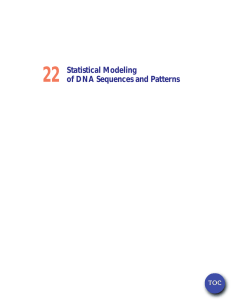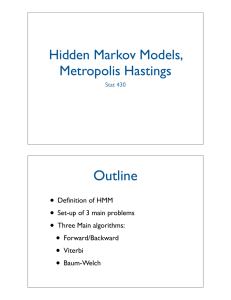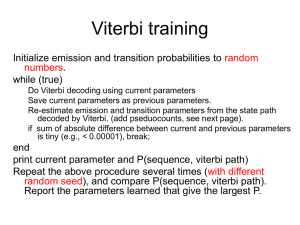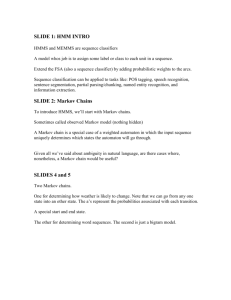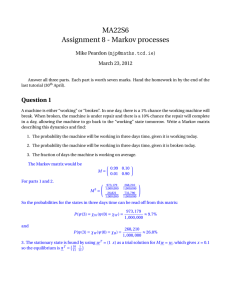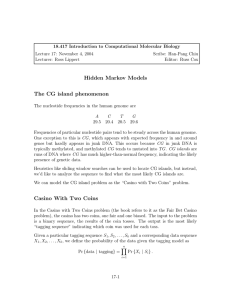Hidden Markov Models, Bayesian Networks Stat 430
advertisement
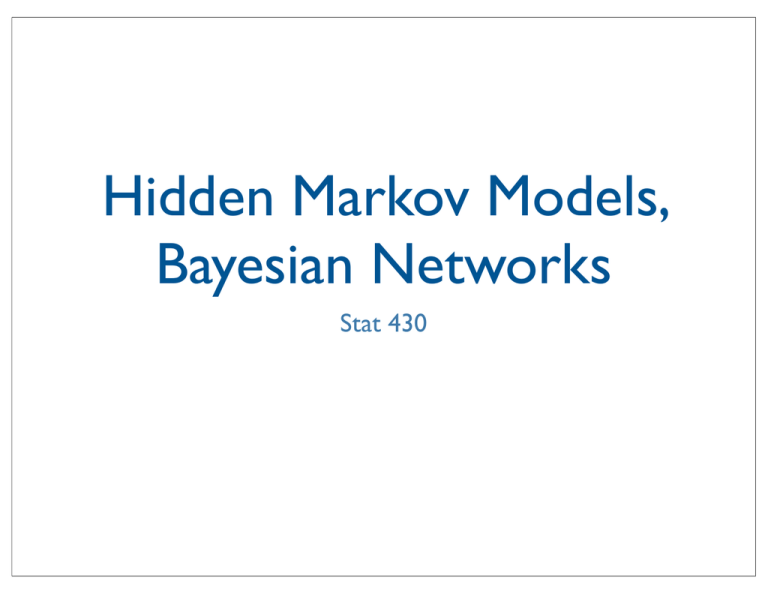
Hidden Markov Models,
Bayesian Networks
Stat 430
Outline
• Definition of HMM
• Set-up of 3 main problems
• Three Main algorithms:
• Forward/Backward
• Viterbi
• Baum-Welch
Hidden Markov Models
(HMM)
• Idea
each state of a Markov chain emits a letter
from a fixed alphabet
distribution of letters is time independent,
but depends on state
• Situation
usually we have string of emitted symbols,
but don’t know Markov Chain (it’s hidden)
Application Areas
• Pattern recognition
• Search algorithms
• Sequence alignments
• Time series analysis
Setup
Markov State Diagram
with transition probabilities A
emission probabilities B
Emitted Sequence Y
Usually, we only observe Y (several instances of it)
Example
• Suppose we have five amino acid sequences
CAEFTPAVH
CKETTPADH
CAETPDDH
CAEFDDH
CDAEFPDDH
• find best possible alignment of all sequences
(allowing insertions and deletions)
Run of an HMM
process:
• 2-step
initial -> emission -> transition -> emission -> transition ->
q1
O1
q2
O2
• Sequence of visited states Q = q
• Sequence of emitted symbols
q3
1
q2 q3 ...
O = O1 O2 O3 ...
• usually we can observe O, but don’t know Q
Example
• Markov Chain with two states, S
1
and transition matrix P
• Emission alphabet {a, b}
• In S emission probabilities
1
for a and b are 0.5 and 0.5
• In S
emission probabilities
for a and b are 0.25 and 0.75
2
• Observed sequence is bbb
and S2
S1
S2
S1
0.9
0.1
S2
0.8
0.2
S1 S2
S1 0.9 0.1
S2 0.8 0.2
transitions
Example
a b
S1 0.5 0.5
S2 0.25 0.75
emissions
• Observed sequence is bbb
• What is the most likely sequence Q that
emitted bbb?
argmaxQ P(Q|O)
• What is the probability to observe O?
P(O) = ∑Q P(O|Q) P(Q)
Definition
A hidden Markov model (HMM) consists of
• set of states S , S , ..., S
• the transition matrix P with
1
2
N
pij = P(qt+1 = Sj| qt=Si)
• an alphabet of M unique, observed symbols
A = {a1, ..., aM}
• emission probabilities
bi(a) = P(state Si emits a)
• initial distribution π = P(q
i
1
= Si )
Three Main Problems
•
Find P(O)
computational problem: naive solution is intractable
foward-backward algorithm
•
Find the sequence of states that most likely
produced observed output O:
argmaxQ = P(Q|O)
Viterbi algorithm
•
for fixed topology find P, B and π that maximize
probability to observe O
Baum-Welch algorithm
Forward/Backward
• given all parameters (B, Q, π) find P(O)
• naive approach is computationally too
intensive
• Use help of forwards α and backwards β
• α(t,i) = P(o o … o , q =S )
• then P(O) = ∑ α(T,i)
1 2
i
t
t
i
Viterbi
• compute arg max P(Q | O)
• two-step algorithm:
• maximize probability first,
• then recover structure Q
Q
Baum-Welch
CAEFTPAVH, CKETTPADH, CAETPDDH, CAEFDDH, CDAEFPDDH
HMM for Amino Acid/Gene
Sequences
d1
d2
d3
i0
i1
i2
i3
m0
m1
m2
m3
m4
CAEFTPAVH, CKETTPADH, CAETPDDH, CAEFDDH, CDAEFPDDH
Example
•
CAEFDDH most likely produced by
m0 m1 m2 m3 m4 d5 d6 m7 m8 m9 m10
•
CDAEFPDDH most likely produced by
m0 m1 i1 m2 m3 m4 d5 m6 m7 m8 m9 m10
•
Yields alignment
C -AEF - -DDH
CDAEFP -DDH
R packages
• HMM
• RHmm
• HiddenMarkov
• msm
• depmix, depmixS4
• flexmix
Bayesian Networks
• HMMs are special case of Bayesian Nets
• A Bayesian Network is a directed acyclic
graph,
where nodes represent variables
edges describe conditional relationships
Setup
X3
X1
X5
X2
• If there is no edge between two nodes, the
nodes are independent
• Edges imply parent/child relationship:
•
•
X1 has children X2, X3, X5
X5 has parents X1, X2
• P(X , ..., X ) = ∏ P(X |parents(X ))
1
p
i
i
i
X4
Example
• Given that the grass is wet, what is the
probability that it is raining?
R packages
• deal
• MASTINO
